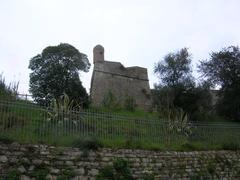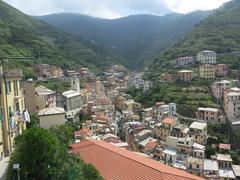
Comprehensive Guide to Visiting Porto Venere, Province of La Spezia, Italy
Date: 13/08/2024
Captivating Introduction
Imagine wandering through a coastal village where ancient Roman temples once graced the landscape and medieval castles still stand tall, guarding the cliffs. Welcome to Porto Venere, a picturesque gem nestled in the Province of La Spezia, Italy. This enchanting town is a tapestry of history, culture, and natural beauty, waiting to be explored by curious travelers. From the echoes of Roman worship at the temple dedicated to Venus Ericina to the poetic whispers of Lord Byron in the grotto that bears his name, Porto Venere is a place where past and present intertwine seamlessly (lecinqueterre.org) (Wikipedia).
Porto Venere’s rich history is palpable in every corner, with its roots tracing back to the 1st century BC. The town’s name itself is derived from a Roman temple dedicated to Venus, the goddess of love and beauty. As you stroll through its narrow alleys, you’ll encounter Genoese fortifications, medieval churches, and colorful houses that have witnessed centuries of maritime adventures and cultural transformations (Visit Porto Venere) (Discover Porto Venere).
But Porto Venere is not just a relic of the past; it is a vibrant living community that continues to inspire artists, writers, and travelers. The town’s inclusion in the UNESCO World Heritage list in 1997, alongside the Cinque Terre and the islands of Palmaria, Tino, and Tinetto, is a testament to its exceptional scenic beauty and the harmonious relationship between people and nature over the centuries (UNESCO).
Whether you’re a history enthusiast, a culinary explorer, or simply seeking a serene escape, Porto Venere promises an adventure as rich and layered as its own history. So, pack your bags, download the Audiala app, and get ready to uncover the secrets and stories of this captivating town.
Table of Contents
History of Porto Venere
Journey Through Time: Ancient and Medieval Origins
Porto Venere, nestled in the picturesque Province of La Spezia, Italy, boasts a history dating back to Roman times. Legend has it, the town’s name originates from a temple dedicated to Venus Ericina, standing where the Church of San Pietro now graces the skyline (lecinqueterre.org). Built in the 5th century, this ancient structure was later transformed in the Genoese Gothic style, echoing the town’s evolving architectural narrative.
Fast forward to the 8th century, when Porto Venere faced the wrath of the Lombards. Administered by the Colombanian monks of the Abbey of Bobbio, the town became a strategic port of call. By the 10th century, it fell under the Lords of Vezzano, vassals of the bishops of Luni. This period cemented Porto Venere’s importance in the region.
Genoese Influence and Fortifications: The Age of Giants
In the early 12th century, Porto Venere was drawn into the orbit of Genoa, a powerhouse maritime republic. The Genoese touch is evident in the town’s key structures—castles, churches, and towering house fortifications (lecinqueterre.org). The castle, erected in 1161, was expanded and fortified between the 15th and 17th centuries, standing as a guardian against invaders.
The 13th century was tumultuous, with the Pisans attacking frequently. In a dramatic turn of events in 1245, Pope Innocent IV sought refuge here, escaping Emperor Frederick II with Genoese support. Porto Venere’s allegiance shifted between Charles VI of France, the Kingdom of Aragon, Florence, and finally, back to Genoa.
Napoleonic Era and Beyond: Winds of Change
The fall of Genoa to Napoleon in the early 19th century ushered in significant changes for Porto Venere. In 1812, a coastal road was built, linking the town to La Spezia via Fezzano and Le Grazie (lecinqueterre.org). This development enhanced access and integration, reshaping the town’s economic and social landscape.
Architectural and Cultural Landmarks: Timeless Echoes
Porto Venere is a treasure trove of architectural marvels. The Church of San Lorenzo, a 12th-century Romanesque gem, underwent significant 16th-century remodeling. It stands as a testament to the town’s religious and architectural heritage.
The Church of San Pietro, perched on the cliffs facing Palmaria island, originally dates back to the 5th century. Over time, it adopted the Genoese Gothic style. Nearby, Byron’s Cave, a natural grotto, is named after the English Romantic poet Lord Byron, who reportedly swam there (lecinqueterre.org).
Hidden Gems: Whispers of the Past
Beyond the famous landmarks, Porto Venere’s charm lies in its lesser-known spots. Fezzano, a quaint village with colorful houses, is home to the Church of San Giovanni Battista. Le Grazie, partly occupied by a military port, features the Church of Nostra Signora delle Grazie (lecinqueterre.org).
Palmaria island, dotted with 19th-century forts like Forte Cavour and Forte Umberto I, and the 20th-century Semaforo Battery, offers historical intrigue. The islets of Tino and Tinetto, further south, house the remains of the 7th-century Abbey of San Venerio and ruins of an early Christian oratory and an 11th-century church, respectively (lecinqueterre.org).
Cultural Significance
Religious Landmarks
The Church of St. Peter, built on the site of the ancient temple of Venus, is one of Porto Venere’s most iconic landmarks. This church, completed in the 13th century in the Genoese Gothic style, offers panoramic views and is a symbol of the town (Visit Porto Venere). Another significant religious site is the Church of San Lorenzo, also known as the Sanctuary of Madonna Bianca, which is the final destination of a traditional procession deeply rooted in local culture (Visit Italy).
Literary Connections
Porto Venere is part of the Gulf of La Spezia, also known as the Gulf of Poets, named for the numerous writers and artists it has attracted over the centuries. The Italian scholar and Renaissance poet Petrarch celebrated Porto Venere in 1338, tying its name to Roman mythology (Discover Porto Venere). The town’s picturesque landscape continues to inspire artists and writers today.
Festivals and Traditions
Porto Venere hosts several local festivals and traditions that reflect its rich cultural heritage. The most notable is the Festa della Madonna Bianca, celebrated on August 17th, which includes a procession to the Church of San Lorenzo. This event commemorates the miraculous preservation of a painting of the Madonna during a fire in 1399 (Visit Italy).
Visitor Tips
Best Time to Visit
The best times to visit Porto Venere are during the shoulder seasons of April-May-June and September-October. These months offer pleasant weather and fewer crowds compared to the peak summer months of July and August (Discover Porto Venere).
Getting There
Porto Venere can be reached by various means:
- By Boat: Regular boat services operate from La Spezia, Lerici, and four of the Cinque Terre towns (except Corniglia). These services typically run from the end of March to the first weekend of November (Nomads Travel Guide).
- By Car: Visitors can drive to Porto Venere, but should note that parking is paid and can be limited during the high season (Nomads Travel Guide).
- By Bus: The ATC bus line 11/P from La Spezia to Porto Venere operates along the scenic shore road (SS530) and departs approximately every 15 minutes (Nomads Travel Guide).
Accommodation
Porto Venere offers a range of accommodation options, including the Grand Hotel Portovenere, the only 5-star hotel in the area. This boutique hotel, housed in a building dating back to the 1600s, offers scenic views and a rich historical ambiance (Discover Porto Venere).
Key Attractions
- Doria Castle: This 12th-century fortress offers stunning views of the town and the Gulf of Poets. It is one of the most majestic castles in Liguria and is easily accessible through an elegant portal (Visit Italy).
- Church of St. Peter: Known for its panoramic views and Gothic architecture, this church is a must-visit landmark (Visit Porto Venere).
- Regional Natural Park: The Porto Venere Regional Natural Park offers a unique landscape with high coasts, caves, and diverse vegetation. The park also includes the Marine Protected Area, known for its crystal-clear waters (Wikipedia).
Dining and Local Cuisine
Porto Venere’s cuisine is a highlight for many visitors. The town is known for its seafood, pesto dishes, and local wines. Dining options range from quaint eateries in the narrow alleys to more upscale restaurants with stunning views of the Gulf of Poets (World Heritage Site).
Outdoor Activities
Porto Venere offers a variety of outdoor activities, including hiking, boating, and exploring the nearby islands of Palmaria, Tino, and Tinetto. The round-the-island hike on Palmaria Island is particularly popular, offering spectacular sunset views over Porto Venere (World Heritage Site).
Cultural Context and Etiquette
When visiting Portovenere, it’s helpful to know a bit about local customs. Italians value politeness, so always greet with a friendly “Buongiorno” (Good morning) or “Buonasera” (Good evening). Tipping is appreciated but not mandatory; rounding up the bill or leaving small change is customary. Dress modestly when visiting churches and religious sites.
Sample Itinerary
Day 1:
- Morning: Arrive in Portovenere, check into your accommodation.
- Afternoon: Explore the historic center and visit the Church of St. Peter.
- Evening: Enjoy dinner at a local seafood restaurant.
Day 2:
- Morning: Take a ferry to explore the Cinque Terre villages.
- Afternoon: Return to Portovenere, visit Byron’s Grotto.
- Evening: Relax with a glass of local wine by the sea.
Call to Action
Porto Venere is more than just a destination; it’s a journey through time, a sensory feast, and a haven for those seeking to immerse themselves in history, culture, and natural beauty. From its ancient Roman roots to its Genoese fortifications and modern-day UNESCO recognition, the town’s multifaceted charm is sure to leave an indelible mark on any visitor (lecinqueterre.org) (Wikipedia).
As you explore Porto Venere, you’ll find that its allure lies not only in its famous landmarks but also in its hidden gems and local secrets. Wander through the narrow streets, savor the local cuisine, and take in the stunning views from the Church of St. Peter or Doria Castle. Engage with the town’s rich cultural heritage through its festivals, traditions, and literary connections, and let the stories of the past come alive (Visit Porto Venere) (Discover Porto Venere).
So, are you ready to embark on an unforgettable adventure in Porto Venere? Download Audiala, your perfect travel companion, and let it guide you through the town’s rich history, cultural landmarks, and hidden treasures. With Audiala, you’ll have expert insights and local tips at your fingertips, making your visit to Porto Venere an enriching and memorable experience. Don’t miss out on the chance to uncover the secrets and stories of this enchanting town—your Porto Venere adventure awaits!
References
- Porto Venere: A Timeless Voyage, 2024 Wikipedia
- Porto Venere: A Timeless Voyage, 2024 Visit Porto Venere
- Porto Venere: A Timeless Voyage, 2024 Discover Porto Venere
- Porto Venere: A Timeless Voyage, 2024 UNESCO
- History of Porto Venere, 2024 lecinqueterre.org
- Visitor Tips for Portovenere, Province of La Spezia, Italy, 2024 Porto Venere
- Visitor Tips for Portovenere, Province of La Spezia, Italy, 2024 She Goes The Distance
- Visitor Tips for Portovenere, Province of La Spezia, Italy, 2024 My Adventures Across The World



